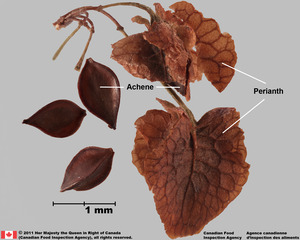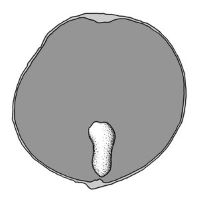Content is from Kirkbride et al. 2006Kirkbride et al. 2006:
Kirkbride JH, Jr, Gunn CR, and Dallwitz MJ. 2006. Family guide for fruits and seeds, vers. 1.0. Accessed September 2020-January 2022. URL: https://nt.ars-grin.gov/seedsfruits/keys/frsdfam/index.cfm ., without modification.
Updates are forthcoming.
Fruits: Pistil(s) simple, or compound; 1; 1-pistillate; with carpels united. Fruit anthocarpanthocarp:
simple or compound and including some tissue of non-ovarian origin (accessory tissue) , or pericarpium; simple; berryberry:
, or pericarpium; simple; berryberry:
an indehiscent, fleshy fruit with one or a few to many seeds. The flesh may be homogenous throughout. Or, if the outer part is hard, firm, or leathery, referred to as an hesperidium. Septa are present in some, and the seeds may be arillate or with a fleshy testa. (of authors, but not Spjut), or acheneachene:
(of authors, but not Spjut), or acheneachene:
a dry, indehiscent, one-seeded fruit, with seed attached to pericarp at a single point, derived from a single, superior, simple or compound, one-loculed ovary (of authors, but not Spjut); simple, or compound; sorosussorosis:
(of authors, but not Spjut); simple, or compound; sorosussorosis:
a multiple fruit composed of two or more fleshy fruitlets that developed on a peduncle
(Helosis mexicana); without persistent central column; within accessory organ(s), or not within accessory organ(s); within other genera pedicelpedicel:
the stalk of a flower
, or perianthperianth:
collective term for calyx and corolla of a flower
 (swollen perianthperianth:
(swollen perianthperianth:
collective term for calyx and corolla of a flower
 tube for Mystropetalon); with 1–3(–5)-carpellate; with carpels united; with carpels remaining united at maturity; without sterilesterile:
tube for Mystropetalon); with 1–3(–5)-carpellate; with carpels united; with carpels remaining united at maturity; without sterilesterile:
lacking male and/or female reproductive parts; also, not producing fruit or seed
 carpels; apexapex:
carpels; apexapex:
the point farthest from the point of attachment, or the "tip" of an organ not beaked; wall leatheryleathery:
not beaked; wall leatheryleathery:
texture—moderately thick, tough, and very pliable
; indehiscentindehiscent:
not opening on its own, as in a fruit
 . Epicarpepicarp:
. Epicarpepicarp:
outer layer of fruit wall or pericarp, if divided into layers; note here used synonymously with exocarp without armature; without wing(s); without apicalapical:
without armature; without wing(s); without apicalapical:
at or pertaining to the end of the seed or fruit distal from its point of attachment (i.e., base)
respiratory hole. Funiculusfuniculus:
(alt. funicle) stalk connecting the ovule (later seed) to the ovary (later fruit) placenta short; short without seed bearing hookswith hooks:
short; short without seed bearing hookswith hooks:
bristles or spines with curved or backwards pointing tips, or with secondary bristles along their length (retinacula); not persisting in fruit after seed shed.
(retinacula); not persisting in fruit after seed shed.
Seeds: Arilaril:
(broad sense) appendicular structure that wholly or partly envelops a seed and is produced from or a modification of the funicle, raphe, or outer integument; usually fleshy or pulpy, sometimes spongy or tufted-capillate, often brightly colored absent. Seed larger than minute; less than 1 mm long (assumed); not bowl shaped; not nutlike; without winglike beakbeak:
absent. Seed larger than minute; less than 1 mm long (assumed); not bowl shaped; not nutlike; without winglike beakbeak:
a usually firm, terminal appendage, sometimes tapered ; without caudatecaudate:
; without caudatecaudate:
tapering to a long, tail-like appendage appendage(s); at maturity with food reserves; with endosperm. Sarcotestasarcotesta:
appendage(s); at maturity with food reserves; with endosperm. Sarcotestasarcotesta:
pulpy or fleshy outer layer of the seed coat, simulates aril absent. Testatesta:
absent. Testatesta:
seed coat
 present; without glands; without wings; without collar; without operculumoperculum:
present; without glands; without wings; without collar; without operculumoperculum:
a dehiscent cap (or lid) of a seed or fruit that opens during germination or dehiscence ; colored; monochrome; not becoming mucilaginousmucilaginous:
; colored; monochrome; not becoming mucilaginousmucilaginous:
resembling mucilage; moist and sticky
when wetted. Endosperm copious (more or less); fleshy; smooth; without apicalapical:
at or pertaining to the end of the seed or fruit distal from its point of attachment (i.e., base)
lobes. Embryo differentiated from food reserve, or undifferentiated from food reserve; rudimentaryrudimentary:
(of embryo) embryo is small and fills less than a quarter of the seed and can be variable in shapes, such as linear, spatulate, or oval ; 1 per seed; partially filling testatesta:
; 1 per seed; partially filling testatesta:
seed coat
 (with food reserve); 0.3 times the length of food reserve (open to question); at one end of seed not extending into a depression or cup; without coleorhiza; acotyledonous, or with 2 or more cotyledons (barely). Cotyledons barely 2; scarcely differentiated, or tiny; equal in size; not punctatepunctate:
(with food reserve); 0.3 times the length of food reserve (open to question); at one end of seed not extending into a depression or cup; without coleorhiza; acotyledonous, or with 2 or more cotyledons (barely). Cotyledons barely 2; scarcely differentiated, or tiny; equal in size; not punctatepunctate:
surface relief—dotted with pits or with translucent, sunken glands or with colored dots, similar to pitted dotted. Hypocotyl-radicle vestigial (assumed); not thickened.
dotted. Hypocotyl-radicle vestigial (assumed); not thickened.
Literature specific to this family: Hansen, B. 1972. The genus Balanophora J.R. & G. Forster: A taxonomic monograph. Dansk Bot. Ark. 28:1–188; Hansen, B. 1980. Balanophoraceae. Fl. Neotrop. Monogr. 23:1–75; Kuijt, J. 1969. The biology of parasitic flowering plants. University of California Press, Berkeley; Makino, T. 1909. Observations of the flora of Japan. Bot. Mag. (Tokyo) 23:23 & 58–60.
General references: Baillon, H.E. 1866–95. Histoire des plantes, 13 vols. Hachette & Co., Paris, Cronquist, A. 1981. An integrated system of classification of flowering plants, 1,262 p. Columbia University Press, New York, Goldberg, A. 1986 (dicots) & 1989 (monocots). Classification, evolution, and phylogeny of the familes of Dicotyledons. Smithsonian Contr. Bot. 58 for dicots (314 pp.) & 71 for monocots (74 pp.). [Goldberg's illustrations are reproduced from older publications and these should be consulted], Gunn, C.R., J.H. Wiersema, C.A. Ritchie, & J.H. Kirkbride, Jr. 1992 & amendments. Families and genera of Spermatophytes recognized by the Agricultural Research Service. Techn. Bull. U.S.D.A. 1796:1–500, LeMaout, E. & J. Decaisne. 1876. A general system of botany, 1,065 p. Longmans, Green, & Co., London, and Spjut, R.W. 1994. A systematic treatment of fruit types. Mem. New York Bot. Gard. 70:1–182.